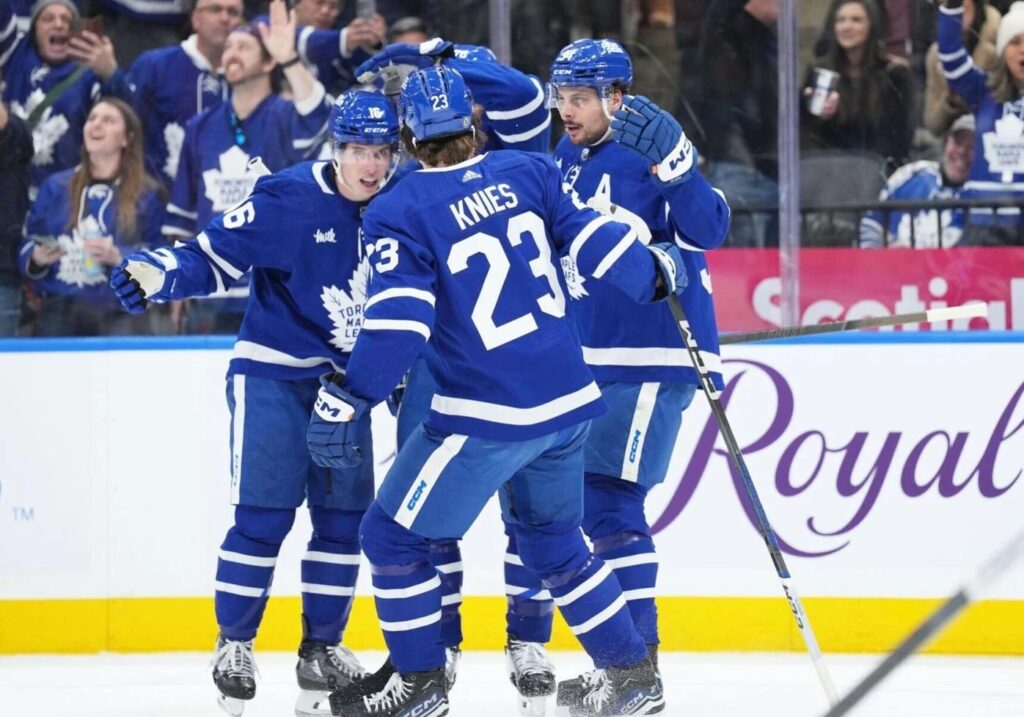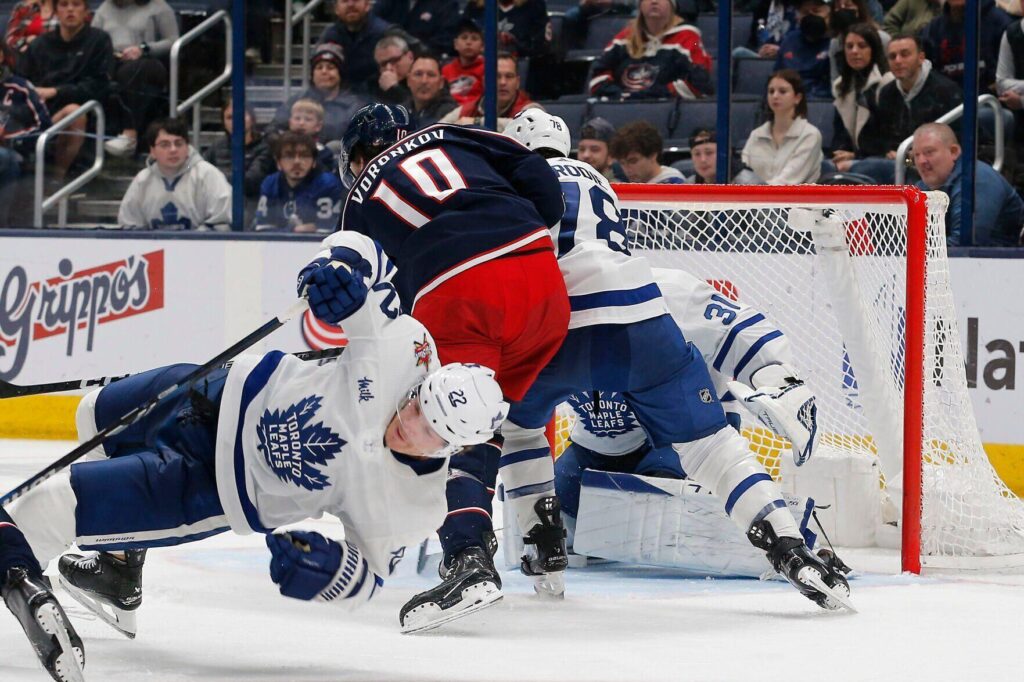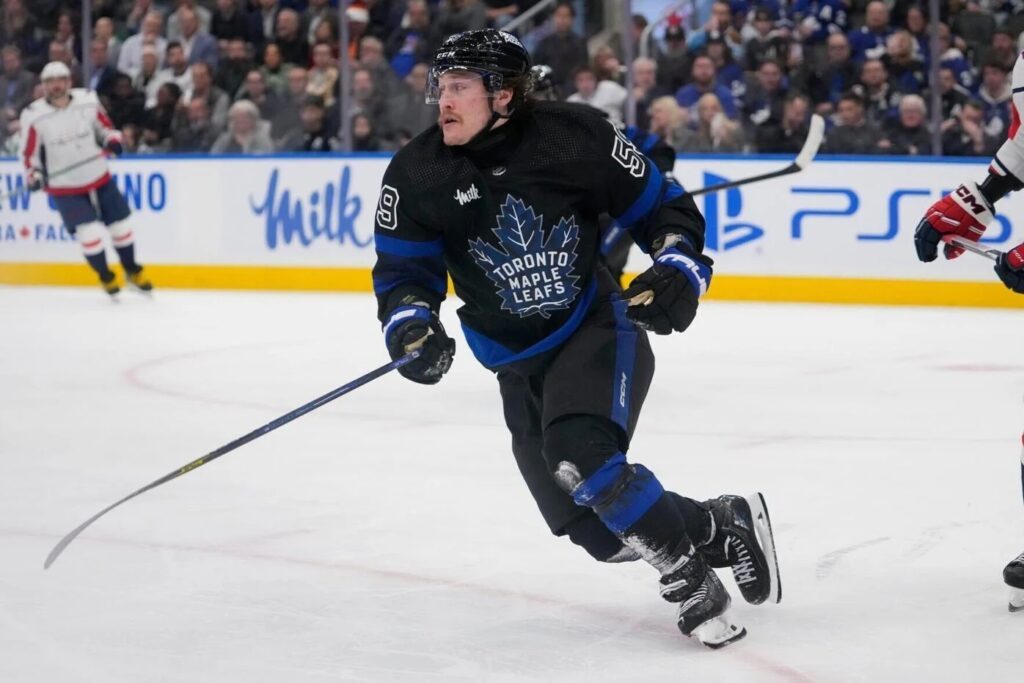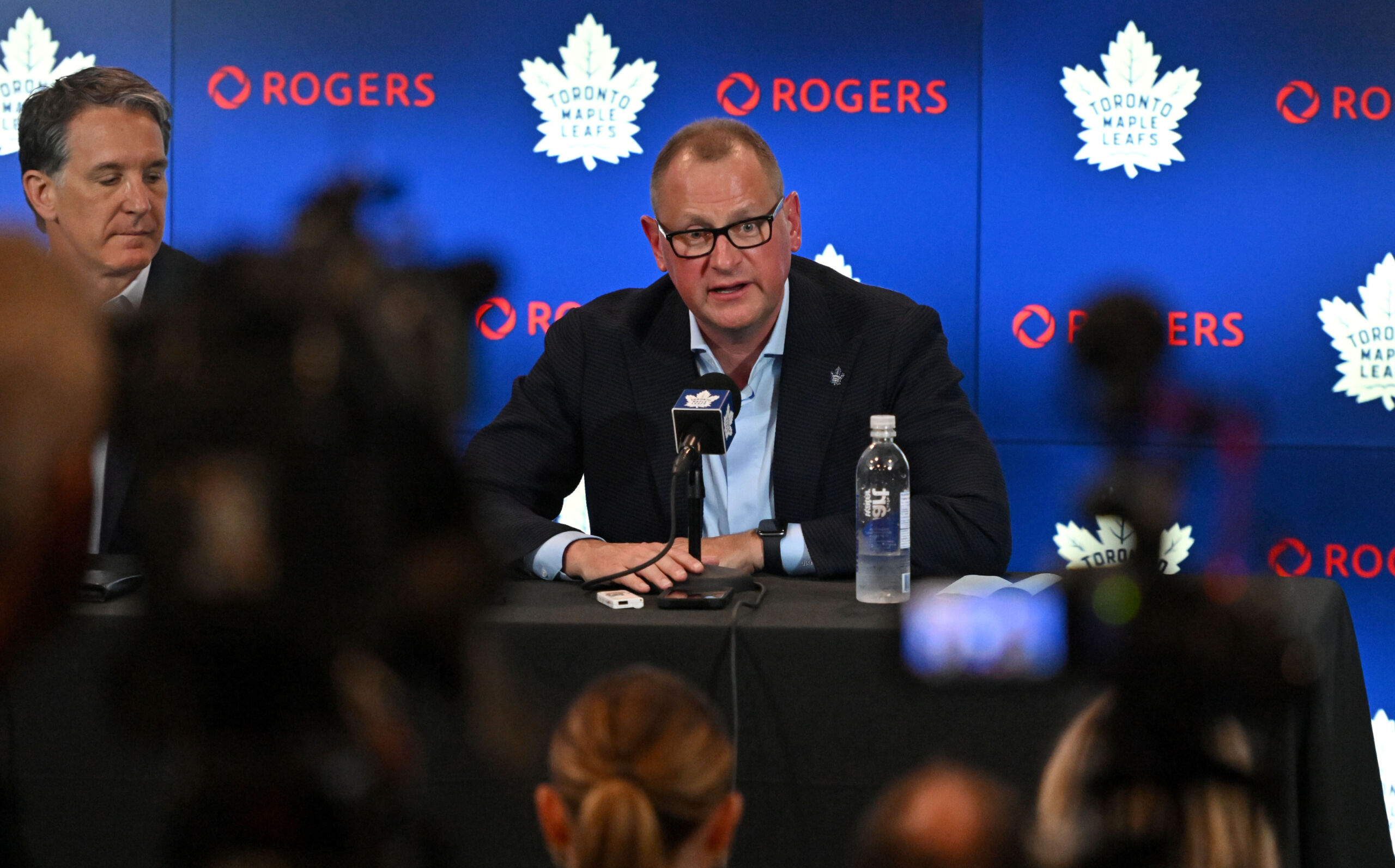Over the past few weeks, we reviewed all the Maple Leafs’ players under contract as well as their pending UFAs and RFAs:
- Offseason Evaluations, Part 1: Auston Matthews & William Nylander
- Offseason Evaluations, Part 2: Mitch Marner & John Tavares
- Offseason Evaluations, Part 3: David Kampf & Calle Jarnkrok
- Offseason Evaluations, Part 4: Bobby McMann & Matthew Knies
- Offseason Evaluations, Part 5: Pontus Holmberg & Ryan Reaves
- Offseason Evaluations, Part 6: Morgan Rielly & Conor Timmins
- Offseason Evaluations, Part 7: Jake McCabe & Simon Benoit
- Staying or Going, Part 1: Max Domi, Tyler Bertuzzi, Ilya Samsonov, Martin Jones, Noah Gregor & Connor Dewar
- Staying or Going, Part 2: Joel Edmundson, Ilya Lyubushkin, TJ Brodie & Timothy Liljegren
It was a worthwhile exercise, and if you haven’t read through the articles yet, I highly recommend it. They help frame where each player could/should slot in the team’s lineup in 2024-25, which is particularly important considering the Leafs already have 10 forwards, four defensemen, and a goalie signed.
Theoretically, this could mean they only add four players plus a goalie to fill out the remaining spots. Now, we are not expecting that to happen – nor should it – so after evaluating each player, I wanted to put it all together by discussing the state of the roster, who they may try to move out/upgrade, how the team’s own RFAs and UFAs may fit into the puzzle moving forward, and where the Leafs need to focus their available cap space.
If all of Toronto’s under-contract players were to return (again, unlikely), the most simple lineup projection looks like this:
_____ – Matthews – Marner
Knies/McMann – Tavares – Nylander
Knies/McMann – _____ – Jarnkrok
Holmberg – Kampf – Reaves
Rielly – _____
Benoit – McCabe
_____ – Timmins
Woll
_____
A few notes by position:
Forward

In terms of roster building, you can feasibly argue which of Knies or McMann should be on the second or third lines, but for our purposes in this piece, it’s basically meaningless. You could even reasonably argue that Knies can play on the top line — given that he did it for much of last season — while hoping he continues to trend up next season. No matter what, they are locked in and will slot in among the top-nine forward group.
The other left-wing spot in the top nine is up for debate. We can see why the Leafs have been linked to a collection of left-wingers, be it keeping Tyler Bertuzzi, reuniting with former draft pick Dakota Joshua, or signing playoff nemesis Jake DeBrusk, to name a few. They need another left winger of consequence, and depending on who they add, you could argue for any of Knies/McMann/the additional winger to slot into any of the top three lines. I like Knies and McMann, but preferably, the Leafs add someone with a track record of production, knowing both bring question marks.
I have also slotted Pontus Holmberg in as 4LW instead of at center. Holmberg is a handy player who played to a 26-point pace (over 82 games) last season, but a good chunk of his production came while playing on the wing, especially when he was skating alongside the Leafs‘ top players. He played center the entire time in the playoffs, went pointless, and wasn’t particularly dangerous.
As a 4C, I think Holmberg would work as an experiment, but as a 3C with an offensively limited David Kampf behind him, it would make for two offensively inept lines, which wouldn’t make much sense. It would be fine if they were to move Kampf for cap-related reasons and try out Holmberg at 4C (while still acquiring a strong 3C), but it would be difficult to show faith in a bottom-six center tandem of Holmberg and Kampf.
Big picture, the Leafs clearly need to add a center of significance. Some of the John Tavares-is-in-decline discussion is probably going a little overboard. He did score 29 goals and 65 points, which is solid 2C production; if we rank those who NHL.com classifies as centermen, he was tied for 38th overall at the position in 2023-24. The Leafs possess an elite 1C above Tavares, so they can, in theory, get away with it from a production standpoint. It’s the play-driving aspect that concerns me.
Tavares’ hands and strength are still there, but his skating is in decline and with it, his ability to drive play. For the regular season, it will probably be fine, but look at this season’s final four and the 2Cs on those teams: Sam Bennett (who handled Tavares easily last spring), Vincent Trocheck (who just compiled 20 points in 16 playoff games), Leon Drasaitl (who needs no introduction), and Wyatt Johnston once Roope Hintz returned. I can’t envision a soon-to-be 34-year-old Tavares winning any of those matchups at any point, let alone three or four rounds into the playoffs.
Defense is rightfully receiving a ton of attention, but center is a huge need. Compounding matters is the mediocrity of the UFA center market, meaning the Leafs will likely need to address this via trade either in the offseason or by the trade deadline. Last offseason, they didn’t adequately address the position and started the campaign with Fraser Minten in the 3C spot. If they are serious about winning next season, they need to find a better solution than praying for a rookie to emerge or for Pontus Holmberg to take a massive leap forward in his game.
Other than a center and a left-winger, you could argue that the forward roster is generally set, but there is more to consider. Mitch Marner’s situation is a separate story altogether that we have already discussed once and will discuss again with a follow-up article.
The other player worth mentioning – one I already highlighted in the player reviews but will flag again here – is Calle Jarnkrok. His cap hit is small, and he is a dependable pro who brings an honest effort every night. He chips in offense and is a strong penalty killer. The Leafs can occasionally use him on the power play, move him up and down the lineup, and reasonably play him at every position (though I think he struggles as a center). If the Leafs bring back Jarnkrok, I wouldn’t have an issue with it.
All of that said, Jarnkrok’s playoff history is hard to ignore, with five goals and 22 points in 93 career postseason games. He doesn’t impact the game physically, and while he’s solid defensively, he’s not exactly going to shut down top-line talent. Through two years, I’ve had to look for Jarnkrok in playoff games rather than him leaping off the page with a notable impact in any major facet of the game. Based on this logic, we could argue that the Leafs should move on and restock draft capital.
If they do move on from Jarnkrok, there’s a far clearer path for Nick Robertson to make the team. He played in the lineup regularly while Jarnkrok was injured and produced offense. Even though Robertson was also blanked in the playoffs, the difference is that he’s only 22 (Jarnkrok is 10 years his senior).
Barring a trade – be it Marner or Jarnkrok – there will likely be no real top-nine winger spot available for Robertson. I am assuming the Leafs will land some sort of established left-winger rather than banking completely on an inexperienced trio of Knies, McMann, and Robertson. The right side is in place unless they move a player, and depending on the return, the position might still be accounted for even if they do.
The fourth line is arguably already in place. A pending RFA, Connor Dewar acquitted himself well as an energy player and penalty killer, and he should be cheap and useful enough for the Leafs to retain. In Ryan Reaves’ player review, I noted that he shouldn’t be counted on as an everyday player at this stage of his career. If we include Dewar in the mix for the fourth line with Kampf and Holmberg, it’s a 13-forward roster. If we include Robertson, assuming the Leafs add a center and a left winger, the Leafs would have 14 forwards.
This is to say nothing of Easton Cowan, who is likely ready for a look if nothing else, given he has basically done it all in the OHL. Something will have to give. Too many forwards and not enough spots.
If the Leafs can acquire another center of note, I think it makes moving Kampf far more palatable while running an L4 of Dewar – Holmberg – Reaves and keeping Robertson in the mix. Robertson is young, won’t cost much to keep, and can do the hardest thing to do in the league (score goals). There are limitations to his game, given his size, and if they move him to restock draft capital or potentially include him in a trade to bring back a player who is perhaps a better lineup fit, I can see either scenario making sense. However, in the long-term view, there is merit to keeping Robertson around as a game-breaker with untapped upside while giving Holmberg a full season at 4C and upgrading at the 3C spot significantly.
Defense

On the blue line, there is far less to talk about. That isn’t to say there isn’t much to do, but the path is pretty clear. The Leafs need to make two significant additions.
Morgan Rielly and Jake McCabe are credible top-four defensemen. Simon Benoit showed well and is a mainstay, but he needs to produce more than five points to be a true top-four defenseman. Conor Timmins needs to prove he can stay healthy, and if he does, perhaps he can finally work on refining his game; he’s 6’2 and skilled, but he needs to improve the details in his defensive game, which will only happen with more repetition.
Beyond the obvious need to add two quality defensemen, the main question I’ll be monitoring is whether the Leafs look to move Jake McCabe back to his natural left side. He played better on the right, but I think part of it was simply the benefits of a stable partner in Benoit rather than John Klingberg. I’m sure McCabe would be excellent on the left side playing with, say, Brett Pesce.
When the hockey tightened up in the playoffs, McCabe started to experience some trouble handling forechecks and breaking out cleanly. Once again this spring, the clubs in the Stanley Cup finals ran two lefties and two righties in their top four on defense. We’ll say this every year until we’re blue in the face, but it’s really hard to play the off-side – the margins are already razor thin, and split-second slower execution adds up.
Similar to John Tavares as 2C, can McCabe play the right well in the regular season? He has proven he can. Is it a great playoff strategy? I don’t think so.
The public reporting has made it fairly clear that the Leafs would like to bring back Joel Edmundson, even though he will test free agency next week. He is another lefty. Knowing the interest is there, it appears that Leafs brass would be fine with a defense filled out around four lefties:
Rielly – ____
Benoit – McCabe
Edmundson – ____
Right-handed defensemen are a premium asset. Good ones are extremely difficult to find and expensive to retain. It’s not easy to acquire one, let alone two, but it should be the goal.
The Leafs do have a right-handed defenseman they will need to decide on – Timothy Liljegren is a pending RFA.
Liljegren enjoyed the most productive season of his career in 2023-24 (.42 points per game vs. his .32 average in the previous two seasons), and he stepped up when Morgan Rielly was injured. This was his first playoffs where he was actually a lineup regular, but there were mixed results.
Liljegren was technically fourth in time on ice per game among Leafs defensemen, but he was healthy scratched once and played less as the series went along, including a series low in Game 7. The Leafs look to him to provide offense, but he didn’t record a shot on net in the series and recorded just one assist in six games. It was also the worst underlying season of his career in terms of controlling shot attempts.
We all see the promising flashes with Liljegren, and considering how hard it is to find right-handed defensemen, it would be understandable if they make a cheap third-pair bet to keep him around. His most common partner this season was an aging Mark Giordano, and he also played quite a bit with TJ Brodie, neither of whom was a viable playoff option. How much better would Liljegren be if paired with a capable left-handed partner?
If the cap space is tight because of other additions, the Leafs likely aren’t finding a better right-handed option on the open market. Still, I wouldn’t write Liljegren’s name in marker on this roster, and if I were Brad Treliving, I would explore my options.
Goaltending

In net, I didn’t think there was any reason to cover Ilya Samsonov’s 2023-24 season, as he was almost certainly never coming back. Now, there are reports of the Leafs closing in on an extension with Joseph Woll. The new deal is rumoured at three years in length. He’s already under contract for 2024-25, so it would mean four years of Woll aligning with the four years of Auston Matthews’ new contract.
Woll has the talent to be an above-average starter in the league and arguably possesses an even higher ceiling than that. I believe his talent is worth betting on, but the best ability is availability, where he has chronically fallen short. The Leafs will need to bring in a capable tandem partner and also a third-string goalie they can trust, similar to Martin Jones (if not Martin Jones himself).
The Leafs were 23rd in save percentage last season – a major reason why they lingered in the wildcard race for half the season and finished 10th overall. Even average goaltending would almost certainly have made them a top-seven-ish team. Goaltending can’t be evaluated in a vacuum – the Leafs’ team defense was horrendous for half the season — but simply cleaning up some of the defensive play (partly by acquiring at least one top-four defenseman) along with some stability in net would give the team a chance to actually compete for the division title.
There is an argument to be made for acquiring a quality starter, but there are none on the UFA market, and the ones that moved—Jacob Markstrom and Linus Ullmark—both included a first-round pick going the other way. There were also rumours that Ullmark wouldn’t waive to come to Toronto, and Calgary seemingly does not want to deal with the Leafs.
The Leafs have drafted just 11 times in the past three years and only once in the first round. I don’t think they need to trade more first-round picks to address a volatile position like goaltending, especially when they don’t own a first-, second-, third-, or fourth-round selection in 2025.
It might not work – goaltending is the toughest position to predict in the sport – but I’m okay with betting on Woll’s talent, as long as they find a strong tandem partner and also sign a veteran third-string goalie for support.
To sum up, this is how I view the group at the moment, barring a major trade (which I want to discuss further later this week). They need another center; it’s a huge need. They don’t need a left winger like they need a center, but I’d be looking for one nonetheless. On defense, they definitely need two quality additions, and they need to find a proper tandem partner for Woll (and likely a third-stringer as well). Those are the areas I’ll generally focus on this offseason as we evaluate the Leafs’ moves and how all the puzzle pieces will fit together.
Additional Notes on the Pending Free Agents

– I didn’t write about each UFA for the Leafs, but the one that I would most like to bring back (by far) is Tyler Bertuzzi. He might not have produced as much as fans hoped, nor is he a bruising, physical power forward (at least in the regular season; I thought he was very physical in the playoffs). However, he was a difference-maker for me.
A few things stood out with Bertuzzi when I went through the 2023-24 season. The Bertuzzi – Tavares – Nylander line was the Leafs’ best for the first half of the campaign. When the Leafs broke records on the man advantage in February, Bertuzzi was on the top power-play unit. Towards the end of the season, the Bertuzzi – Matthews – Domi line emerged as their best line. Therefore, Bertuzzi was on the Leafs’ best line for most of the season, and the power play was at its best with him on it.
Bertuzzi’s game can be tough to watch at times, but he does many things right, some of which go under-appreciated. He creates space for teammates along the walls, is effective in front of the net, and isn’t a liability defensively. With his work either in front of the net or on the forecheck (or both), there were more than a handful of goals he had a major hand in without collecting a point. The Leafs can and did trust him to close games.
It took Bertuzzi a while to find his footing, but once he did, he produced. After the All-Star break, he played to a 36-goal, 55-point pace (although he did shoot 20%, so I would pump the brakes slightly here). Along with Knies and McMann, it’s a good mix of left-wingers who can all produce and bring something slightly different to the mix, along with their size and physicality. As Tavares ages out, Bertuzzi would also be an excellent net-front replacement option.
I wouldn’t give Bertuzzi more than the four years of Matthews’ contractual term, and if the Leafs stretched out the term that far, his annual average would also have to start with a four for me. But he’s a good player and one I would prefer to keep around. The Ryan Hartman three-year, $4 million AAV is relevant, as is Ivan Barbashev’s 5×5 contract; Bertuzzi should slide somewhere in between this range, even with a rising cap. Of course, I’d pay slightly more to keep the term at less than four years.
– While I liked Max Domi as a Leaf, the prospect of bringing him back hinges a lot more on a team-friendly AAV with a limited term attached to it. Domi is an excellent passer who showed well alongside Matthews, but he struggles defensively. It’s difficult when a coach has to hide a player like Domi. Again, like Tavares’ situation and McCabe on the left, it can work in the regular season, but it becomes much more complicated to manage in the playoffs.
When Dallas went to the Western Conference Finals, Domi was productive but was ninth among their forwards in time on ice per game. I like Domi’s jam. He’s a good skater and has some flair for the big moments. At a cheap price, it’s appealing, but the Leafs have to be careful.
I am looking at Domi’s previous $3 million cap hit with maybe a touch of cap inflation added to it. He signed his previous contract with the Leafs following a season where he was more productive between Chicago/Dallas and produced a better playoffs for the Stars.
Again, it’s difficult knowing Domi needs to be sheltered. He has to produce to justify his role, which he does, so it’s palatable within reason. Generally speaking, though, I believe strong two-way players deliver championships. The Panthers hid nobody in their top nine. Neither did Vegas, and neither did Tampa Bay.
– One Leaf from last season who I liked relative to expectations and who put together a strong 2023-24: William Lagesson. He was claimed on waivers by Anaheim and had a tough go of it on a terrible Ducks team, but he was solid in his time in Toronto, played with some jam, and played both the left and right side (even with Rielly at one point!). If he can be brought back again as cheap depth, I would do it.
– Ilya Lyubushkin doesn’t seem to be receiving much attention or interest, but he was solid after the Leafs acquired him and was effective in his role in the playoffs. You could argue he didn’t make a glaring mistake in the playoffs through seven games.
The Leafs are making a habit of punting draft picks away for depth right-handed defensemen each trade deadline. I’d rather avoid that altogether and be well-stocked with right-handed options when the offseason is over rather than bleeding more picks for depth next spring.
Lyubushkin made $2.75 million per season after he left the Leafs the first time; I wouldn’t come close to matching that number, so maybe he is priced out. But if it’s cheap and reasonable, and depending on what else the Leafs do, I wouldn’t close the door.
– I would not qualify Noah Gregor. He never developed defensively into a player the team could trust, and his offense completely dried up. His speed is top-notch, and he has a pretty good shot, but he didn’t drive the net with his speed, and his game progressively worsened as the season went along. It’s no big deal if he’s kept around as depth and comes to training camp to compete for a job, but I’d rather use the contract spot elsewhere.

































